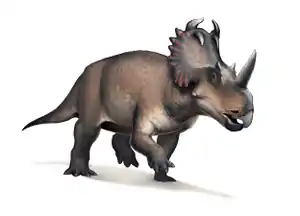Vagaceratops
Vagaceratops (meaning "wandering (vagus, Latin) horned face", in reference to its close relationship with Kosmoceratops from Utah) is a genus of herbivorous ceratopsian dinosaur. It is a chasmosaurine ceratopsian which lived during the Late Cretaceous period (late Campanian) in what is now Alberta. Its fossils have been recovered from the Upper Dinosaur Park Formation.[1] It is sometimes included in the genus Chasmosaurus as Chasmosaurus irvinensis instead of being recognized as its own genus.
| Vagaceratops Temporal range: Late Cretaceous, | |
|---|---|
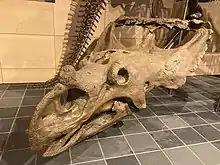 | |
| Cast of the holotype skull, Canadian Museum of Nature | |
| Scientific classification | |
| Domain: | Eukaryota |
| Kingdom: | Animalia |
| Phylum: | Chordata |
| Clade: | Dinosauria |
| Clade: | †Ornithischia |
| Suborder: | †Ceratopsia |
| Family: | †Ceratopsidae |
| Subfamily: | †Chasmosaurinae |
| Genus: | †Vagaceratops Sampson et al., 2010 |
| Species: | †V. irvinensis |
| Binomial name | |
| †Vagaceratops irvinensis (Holmes et al., 2001 [originally Chasmosaurus]) | |
| Synonyms | |
| |
Description
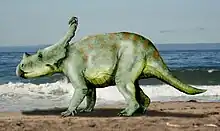
Vagaceratops was a medium-sized ceratopsian, reaching 4.5 m (15 ft) in length and weighing 1.2 t (1.3 short tons).[2] It is known primarily from three fossil skulls. Although the general structure was typical of ceratopsids (i.e. a parrot-like beak, large neck frill, and nasal horn) it has some peculiarities. The skulls are characterized by a reduced supraorbital horn, brow horns that are reduced to low bosses and a larger snout compared to related animals. Vagaceratops had smaller parietal fenestrae than most ceratopsids and had a strange configuration of epoccipitals (bones surrounding the frill). It possessed ten epoccipitals, eight of which were centrally flattened, curved forward and upward and fused together to form a jagged margin along the back of the frill. The frill was shorter and more square-shaped than other chasmosaurines, being wider than it was long.
Classification

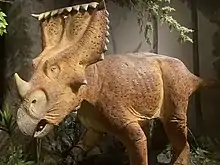
Vagaceratops was named by Scott D. Sampson, Mark A. Loewen, Andrew A. Farke, Eric M. Roberts, Catherine A. Forster, Joshua A. Smith, and Alan L. Titus in 2010, and the type species is Vagaceratops irvinensis.[1] This species was originally described as a species of Chasmosaurus (C. irvinensis) in 2001.[3] Its relationships remain debated. Vagaceratops has variously been allied with Kosmoceratops[1] or with Chasmosaurus.[4][3]
The cladogram below is the phylogeny of the Chasmosaurinae by Brown et al. (2015):[5]
| Ceratopsidae |
| ||||||||||||||||||||||||||||||||||||||||||||||||||||||||||||||||||||||||||||||||||||||||||||||||||||||||||||||||||||||||
Recently it has been suggested that Chasmosaurinae had a deep evolutionary split between a Chasmosaurus clade and a Pentaceratops clade. Vagaceratops was hypothesized to be the last member of the Chasmosaurus clade from northern Laramidia, with the last representative of the clade being its close relative Kosmoceratops.[6]
See also
References
- Scott D. Sampson; Mark A. Loewen; Andrew A. Farke; Eric M. Roberts; Catherine A. Forster; Joshua A. Smith & Alan L. Titus (2010). "New Horned Dinosaurs from Utah Provide Evidence for Intracontinental Dinosaur Endemism". PLOS ONE. 5 (9): e12292. Bibcode:2010PLoSO...512292S. doi:10.1371/journal.pone.0012292. PMC 2929175. PMID 20877459.
- Paul, G. S. (2016). The Princeton Field Guide to Dinosaurs (2 ed.). Princeton: Princeton University Press. p. 296. ISBN 978-0-691-16766-4.
- R. B. Holmes; C. A. Forster; M. J. Ryan & K. M. Shepherd (2001). "A new species of Chasmosaurus (Dinosauria: Ceratopsia) from the Dinosaur Park Formation of southern Alberta". Canadian Journal of Earth Sciences. 38 (10): 1423–1438. Bibcode:2001CaJES..38.1423H. doi:10.1139/cjes-38-10-1423.
- Longrich, N.R., 2011. Titanoceratops ouranos, a giant horned dinosaur from the Late Campanian of New Mexico. Cretaceous Research 32, 264-276.
- Brown, Caleb M.; Henderson, Donald M. (June 4, 2015). "A new horned dinosaur reveals convergent evolution in cranial ornamentation in ceratopsidae". Current Biology. 25 (12): 1641–8. doi:10.1016/j.cub.2015.04.041. PMID 26051892.
- Fowler, Denver W.; Fowler, Elizabeth A. Freedman (2020-06-05). "Transitional evolutionary forms in chasmosaurine ceratopsid dinosaurs: evidence from the Campanian of New Mexico". PeerJ. 8: e9251. doi:10.7717/peerj.9251. ISSN 2167-8359. PMC 7278894. PMID 32547873.
External links
- Vagaceratops irvinensis at the Canadian Museum of Nature
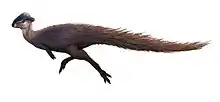
.png.webp)


